Varied difficulty levels in AP Inter 1st Year Zoology Model Papers Set 8 cater to students with diverse academic strengths and challenges.
AP Inter 1st Year Zoology Model Paper Set 8 with Solutions
Time : 3 Hours
Max. Marks: 60
General Instructions:
Note : Read the following instructions carefully.
- Answer All questions of Section A. Answer ANY SIX questions in Section B and answer ANY TWO questions in Section C.
- In Section A questions from Sr. Nos. 1 to 10 are of “Very Short Answer Type”. Each question carries TWO marks. Every answer may be limited to 5 lines. Answer all these questions at one place in the same order.
- In Section ‘B’, questions from Sr. Nos. 11 to 18 are of “Short Answer Type”. Each question carries FOUR marks. Every answer may be limited to 20 lines.
- In Section ‘C’, questions from Sr. Nos. 19 to 21 are of “Long Answer Type”. Each question carries EIGHT marks. Every answer may be limited to 60 lines.
- Draw labelled diagrams wherever necessary in Sections ‘B’ and ‘C’.
Section – A (10 × 2 = 20 Marks)
I. Answer all the questions (Very short answer type)
Question 1.
“Zoos are tools for classification” explain.
Answer:
Zoos are the places where wild animals, taken out of their natural habitat, are placed in protected environment under human care. This enables us to study the various aspects of animal living. Thus it enables us to systematise the organism and position it in the animal world.
Question 2.
What is monaxial heteropolar symmetry ? Name the group of animals in which it is the principal symmetry.
Answer:
When any plane passing through the central axis of the body divides an organism into two identical parts it is called monaxial heteropolar symmetry. In cnidarians it is the principal symmetry.
Question 3.
What are the two chief morphological body forms of cnidarians? What are their chief functions ?
Answer:
The two chief morphological body forms of cnidarians are 1) Polyp 2) Medusa. Polyp is sessile, cylindrical form and produce medusae asexually by budding. Medusa is umbrella shaped and free swimming form and sexually produce polypoid forms.
![]()
Question 4.
List out the characters shared by chordates and echinoderms.
Answer:
Chordates share deuteostomeate condition, radial and indeterminate type of cleavage and enterocoelom with the echinoderms.
Question 5.
What do you mean by parasitic castration ? Give one example.
Answer:
Some parasites cause the degeneration of gonads of the host, making it sterile. This effect in called parasitic castration. eg : Sacculina (a crustacean) causes degeneration of ovaries in the crab.
Question 6.
What are the structures with which cockroach walks on smooth surfaces and on rough surfaces respectively.
Answer:
The claws and the arolium help in locomotion on rough surfaces whereas plantulae are useful on smooth surfaces.
Question 7.
What is intima ?
Answer:
Trachea in cockroach is made up of three layers, outer basement membrane, a middle one cell thick epithelium and an inner layer of cuticle called intima. The intima is produced into spired thickenings called taenidia.
Question 8.
What is the effect of light on body pigmentation ?
Answer:
Light influences the colour of the skin. The animals which live in regions of low intensity of light have less pigmentation than that of the animals exposed to light.
Question 9.
What is Periphyton ?
Answer:
The animals that are attached to / creeping on the aquatic plants, such as the water snails, nymphs of insects bryozoans, hydras constitute the periphyton.
Question 10.
Explain the process of leaching.
Answer:
By the process of leaching, water soluble in organic nutrients go down info the soil and get precipitated as unavailable salts.
![]()
Section – B (6 × 4 = 24 Marks)
II. Answer any six questions (Short answer type)
Question 11.
Define species. Explain the various aspects of “Species”.
Answer:
Species : Species is the ‘basic unit’ of classification. Species is a Latin word meaning ‘kind’ or ‘appearance’. John Ray in his book ‘Historia Generalis Plantarum’, used the term ‘species’ and described it on the basis of common descent (origin from common ancestors) as a group of morphologically similar organisms. Linnaeus considered species, in his book ‘Systema Naturae’, as the basic unit of classification.
Buffon’s biological concept of species explains that species is an interbreeding group of similar individuals sharing the common ‘gene pool’, and producing fertile offspring. Species is considered as a group of individuals which are :
- Reproductively isolated from the individuals of other species – a breeding unit.
- Sharing the same ecological niche – An ecological unit.
- Showing similarity in the karyotype – a genetic unit.
- Having similar structure and functional characteristics – an evolutionary unit.
- Species is dynamic.
Question 12.
Describe the three types of cartilage.
Answer:
The three types of cartilage are
1. Hyaline cartilage
2. Elastic cartilye
3. Fibrous cartilage.
1. Hyaline cartilage: It is bluish-white, translucent and glass-like cartilage. Matrix is homogeneous and shows delicate collagen fibres. It is the weakest and the most common type of all the cartilages. Perichondrium is present except in articular cartilages. It forms the embryonic endoskeleton of bony vertebrates, endoskeleton of cyclostomes and cartilaginous fishes. It forms the articular cartilages (free surfaces of long bones that form joints), costal cartilages (sternal parts of ribs), and the epiphyseal plates. It also forms the nasal septal cartilage, cartilaginous rings of trachea, bronchi and cartilages of larynx.
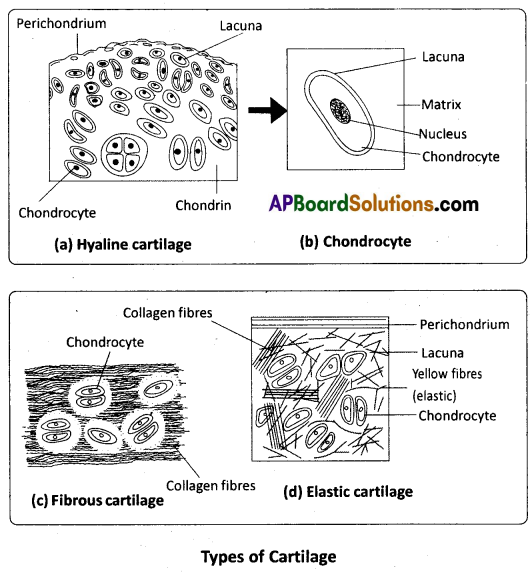
2) Elastic cartilage : It is yellowish due to elastic fibres. Matrix has abundance of yellow elastic fibres in addition to collagen fibres. It provides strength and elasticity. Perichondrium is present. It is found in the pinnae of the external ears, Eustachian tubes and epiglottis.
3) Fibrous cartilage : Matrix has bundles of collagen fibres. Perichondrium is absent. It is the strongest of all types of cartilages. It occurs in the intervertebral discs and pubic symphysis of the pelvis.
Question 13.
What are the chief characters of the crustaceans ?
Answer:
- They are aquatic.
- Head and thorax fuse forming the cephalothorax (covered by chitinous carapace). In some the exoskeleton is hardened by calcium carbonate (crabs and lobsters).
- Cephalic region bears two pairs of antennae (antennules and antennae – unique feature), one pair of mandibles and two pairs of maxillae.
- Thoracic and abdominal appendages are ‘biramous’.
- Respiratory organs are gills (branchiae).
- Excretory organs are green glands or antennary glands.
- Sense organs include antennae compound eyes, statocysts, etc.
- Development is indirect and includes different larval forms. Examples : Palaemon (freshwater prawn), Cancer (crab), Balanus (rock barnacle), Sacculina (root-headed barnacle), Astacus (crayfish), Daphnia (waterflea).

![]()
Question 14.
List out eight characteristics that help distinguish a fish from the other vertebrates.
Answer:
Characteristics of group PISCES :
- Fishes are completely aquatic poikMo-thermic (cold blooded) animals.
- Body of a fish is usually streamlined and differentiated into head, trunk and tail.
- Exoskeleton consists of mesodermal scales or bony plates. A few are scaleless.
- Endoskeleton may be cartilaginous or bony. Skull is monocondylic. Vertebrae are amphicoelous (centrum is concave at both anterior and posterior faces).
- Locomotion is assisted by unpaired (median and caudal) fins along with paired (pectoral and pelvic) fins.
- Mouth is ventral or terminal. Teeth are usually acrodont, homodont and polyphyodont.
- Exchange of respiratory gases is performed by the gills.
- Heart is ‘two chambered’ and is described as ‘branchial heart’ as it supplies blood only to the gills.
- Lateral line sensory system is well developed.

Question 15.
Describe the process of longitudinal binary fission in Euglena.
Answer:

During the process of binary fission, the nucleus, basal granules, chromatophores, cytoplasm undergo division. The nucleus divides by mitosis into two daughter nuclei. Then the kinetosomes and the chromatophores also divide. At first, a longitudinal groove develops in the middle of the anterior end. This groove extends gradually towards the posterior end until the two daughter individuals are separated. One daughter Euglena retains the parental flagella. The other daughter individual develops new flagella from the newly formed basal granules. The stigma, paraflageliar body and contractile vacuole of the parent disappear. They develop afresh in both the daughter euglenae. The longitudinal binary fission is known as symmetrogenic division, because the two daughter euglenae resemble each other like ‘mirror images’.
Question 16.
Draw neat labelled diagram of Paramecium and label its important structures.
Answer:
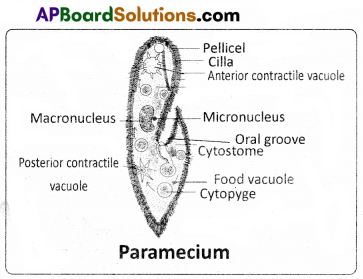
Question 17.
What are the adverse effects of tobacco ?
Answer:
Effect : Smoking increases the carbon monoxide (CO) level and reduces the oxygen level in the blood. Nicotine stimulates the adrenal gland to release adrenaline and nor-adrenajine into blood.
These hormones raise the blood pressure and increase the heart rate. Smoking is associated with bronchitis, emphysema, coronary heart disease, gastric ulcer and increases the incidence of cancers of throat, lungs, urinary bladder etc. Smoking also paves the way to hard drugs. Yet smoking is very pravalent in society, both among young and old. Tobacco chewing is associated with increased risk of cancer of the oral cavity.
Question 18.
Describe the formation of schizocoelom and enterocoelom.
Answer:
Formation of Schizocoelom : Animals in which the body cavity is formed by ‘splitting of mesoderm’ are called schizocoelomates. Annelids, arthropods and molluscs are schizocoelomates in the animal kingdom. All the schizocoelomates are protostomians and they show ‘holoblastic’, ‘spiral’ and ‘determinate’ cleavage. The 4d blastomere or mesentoblast celi of the early embryo divides to form mesodermal blocks between the ectoderm and the endoderm and replaces the blastocoel. The split that appears in each mesodermal block leads to the formation of Schizocoelom. e.g : Annelida, Arthropoda, Mollusca.
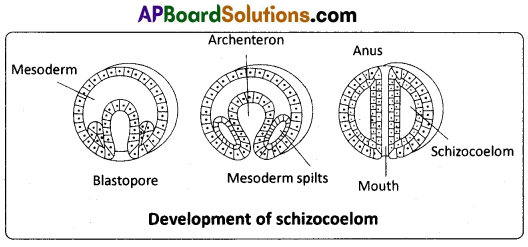
Formation of enterocoelom : Animals in which the body cavity is formed from the mesodermal pouches of archenteron are called enterocoelomates. Echinoderms, hemichordates and chordates are the enterocoelomates. In these animals, mesodermal pouches that evaginate from the wall of the archenteron into the blastocoel are fused with one another to form the enterocoelom. All the enterocoelomates are deuterostonies and they show radial and indeterminate cleavage.

![]()
Section – C (2 × 8 = 16 Marks)
III. Answer any two questions (Long answer type)
Question 19.
Describe the life cycle of Plasmodium Vivax in man.
Answer:
Life cycle of Plasmodium in man (The human phase) : In man, the Plasmodium reproduces by asexual reproduction called schizogony. It occurs in liver cells (hepatocytes) as well as in RBC. In liver cells, it is called hepatic schizogony and in RBC it is called erythrocytic schizogony.
Hepatic schizogony : This was discovered by Shortt and Garnham. Whenever, a mosquito infected by Plasmodium bites a man, nearly 2000 sporozoites are released into the blood of man through its saliva. Within half an hour, they reach the hepatocytes where they undergo pre-erythrocytic and exo- erythrocytic cycles.
Pre-erythrocytic cycle : Whenever the sporozoites reach the liver cells, they transform into trophozoites. Theyfeed on the contents of the hepatic cells, assume spherical shape and attain the maximum size. This stage is called schizont stage. Its nucleus divides several times mitotically, followed by the cytoplasmic divisions resulting in approximately 12,000 daughter individuals called cryptozoites or the lstgeneration merozoites. They enter the sinusoids of the liver by rupturing the cell membrane of the schizont and the liver cells. This entire process is completed approximately in 8 days. Now these first generation merozoites have two options i.e., they can enter either fresh liver cells and continue exo-erythrocytic cycle or they can enter RBC and continue erythrocytic cycle.
Exo-erythrocytic cycle : If the cryptozoites enter the fresh liver cells, they undergo the changes similar to that of the pre- erythrocytic cycle and produce the second generation merozoites called metacryptozoites. These are of two types – the smaller micro- metacryptozoites and larger macro- metacryptozoites. This entire process is completed approximately in two days. The macro-metacryptozoites attack fresh liver cells and continue another exo – erythrocytic cycle, whereas the micro- metacryptozoites always enter blood stream and attack fresh RBC to continue erythrocytic cycle.
Prepatent period : The interval between ‘the first entry of Plasmodium into the blood in the form of sporozoites and the second entry of Plasmodium into the blood in the form of cryptozoites is called prepatent period. It lasts approximately 8 days. During this period, the host does not show any clinical symptoms of the disease. It is only a means of multiplication.
Erythrocytic cycle : It was first described by Camillo Golgi. Hence it is also called Golgi cycle. This cycle is initiated either by the cryptozoites of pre-erythrocytic cycle or the micro- metacryptozoites of exp – erythrocytic cycle. In the fresh RBC, these stages assume spherical shape and transform into trophozoites. It develops a small vacuole which gradually enlarges in size, pushing the cytoplasm and nucleus to the periphery. Now the Plasmodium looks like a finger ring. Hence this stage is called signet ring stage. Soon it loses the vacuole, develops pseudopodia and becomes amoeboid stage. With the help of pseudopodia, it actively feeds on the contents of the RBC and increases in size. As a result, the RBC grows almost double the size.
This process is called hypertrophy. The malaria parasite digests the globin part of the ingested haemoglobin and converts the soluble haem into an insoluble crystalline haemozoin. It is called the ‘malaria pigment’ which is a disposable product. During this stage, small red coloured dots appear in the cytoplasm of the RBC known as Schuffner s dots. These are believed to be the antigens released by the parasite. Now the Plasmodium loses the pseudopodia, further increases in size, occupies the entire RBC and becomes a schizont. It undergoes schizogony similar to that of the pre-erythrocytic cycle and produces 12 to 24 erythrocytic merozoites. They are arranged in the form of the petals of a rose in the RBC. Hence, this stage is called the rosette stage. Finally the erythrocyte bursts and releases the merozoites along with haemozoin into the blood. This cycle is completed approximately in 48 hours.
Incubation Period : The period between ‘the entry of Plasmodium into the blood in the form of sporozoite and the first appearance of symptoms of malaria in man’ is called incubation period. It is approximately 10 to 14 days.
Formation of gametocytes : After repeated cycles of erythrocytic schizogony, when the number of fresh RBC decreases, some merozoites enter the RBC and transform into gametocytes instead of continuing the erythrocytic cycle. This process generally takes place when the RBCs are present in spleen and bone marrow.
The gametocytes are of two types namely, smaller microgametocytes or male gametocytes and larger macrogametocytes or female gametocytes. The gametocytes cannot undergo further development in man as the temperature and pH of the blood of man are not suitable for further development. These gametocytes reach the blood circulation and wait to reach the next host. They degenerate and die if they are not transferred to mosquito within a week.

![]()
Question 20.
Describe the blood circulatory system of peripianeta in detail and draw a neat labelled diagram of it.
Answer:
Circulatory system of Periplaneta : The circulatory system helps in the transportation of digested food, hormones etc., from one part to another in the body. Periplaneta has an open type of circulatory system as the blood, or haemohymph, flows freely within the body cavity or haemocoel. Blood vessels are poorly developed and open into spaces. Visceral organs located in the haemocoel are bathed in the blood. The three main parts associ-ated with the blood circulatory system of Periplaneta are the haemocoel, heart, and blood.
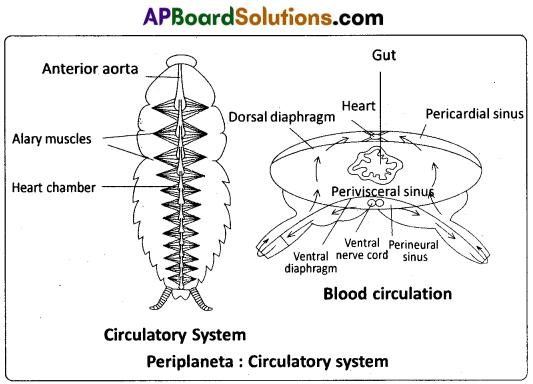
Haemocoel : The haemocoel of cockroach is divided into three sinuses by two muscular, horizontal membranes, called dorsal diaphragm or ‘pericardial septum’ and ventral diaphragm. Both the diaphragms have pores. There is a series of paired triangular muscles, called alary muscles. Every segment has one pair of these muscles situated on the lateral sides of the body. These are attached to the pericardial septum by their broad bases and to the terga by their pointed ends or apices. The three sinuses of the haemocoel are known as pericardial haemocoel orthe ‘dorsal sinus’, the perivisceral haemocoel or the ‘middle sinus’ and eternal haemocoel or ‘vental sinus’ or ‘perineural sinus’. The middle sinus is very large as it contains most of the viscera. The dorsal and ventral sinuses are small as they have only heart and nerve cord, respectively.
Heart : the heart lies in the pericardial haemocoel or dorsal sinus. It is a long, muscular, contractile tube found along the mid dorsal line, beneath the terga of the thorax and abdomen. It consists of 13 chambers. Every chamber opens into the other present in front of it. Three of the thirteen chambers are situated in the thorax and ten in the abdomen. Its posterior end is closed while the anterior end is continued forward as the anterior aorta. At the posterior side of each chamber, except the last, there is a pair of small apertures called ostia’ one on each side. Ostia have valves which allow the blood to pass only into the heart from the dorsal sinus.
Blood : The blood of Periplaneta is colourless and is called haemolymph. it consists of a fluid called plasma, and free blood corpuscles or haemocytes, which are ‘phagocytic’. The phagocytes are large in size and can ‘ingest’ foreign particles such as bacteria. There is no respiratory pigment in the blood and so it plays no major role in respiration. The important functions of the blood are :
- It absorbs digested food from the alimentary canal and distributes it to the rest of the body.
- It brings nitrogenous wastes from all parts of the body to the excretory organs for their elimination.
- It carries defensive phagocytes to the places of infection where they engulf the germs and disintegrating tissue parts.
- It transports secretions of the ductless glands to the target organs.
Circulation of blood: The blood flows forward in the heart by the contractions of its chambers. At the anterior end of the heart, the blood flows into the aorta and from there it enters the sinus of the head. From the head sinus, the blood flows into the perivisceral and sternal sinuses. On contraction of the alary muscles the pericardial septum is pulled down. This increases the volume of the pericardial sinus. Hence blood flows from the perivisceral sinus into the pericardial sinus through the appertures of the pericardial septum. On relaxation of the alary muscles, the pericardial septum moves upwards to its original position. This forces the blood, to enter the chambers of the heart through the ostia from the pericardial sinus.
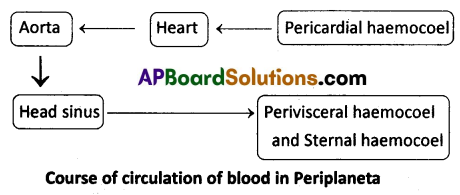
![]()
Question 21.
Write an essay on water as an ecological factor.
Answer:
Water : Water is another important factor influencing the life of organisms. Life is unsustainable without water. Its availability is so limited in deserts that only certain special adaptations make , it possible for them to live there. You might think that organisms living in oceans, lakes and rivers should not face any water-related problems, but it is not true. For aquatic organisms the quality . (chemical composition, pH, etc.,) of water becomes important.
The salt concentration is less than 5 percent in inland waters, and 30 – 35 percent in the seawater. Some organisms are tolerant to a wide range of salinities (euryhaline), but others are restricted ( to a narrow range (stenohaline). Many freshwater animals cannot live for long in sea water and vice versa because of the osmotic problems, they would face.
Adaptations in freshwater habitat : Animals living in freshwaters have to tackle the problem of endosmosis. The osmotic pressure of freshwater is very low and that of the body fluids of freshwater organisms is much higher. So water tends to enter into bodies by endosmosis. To maintain the balance of water in the bodies, the fresh water organisms acquired several adaptation such as, contractile vacuoles in the freshwater protozoans, large glomerular kidneys in fishes, etc.
They send out large quantities of urine, along which some salts are also lost. To compensate the ‘salt loss’ through urine, freshwater fishes have ‘salt absorbing’ ‘chloride cells’ in their gills. The major problem in freshwater ponds is – in summer most of the ponds dry up. To overcome this ) problem most of the freshwater protists undergo encystment. The freshwater sponges produce asexual reproductive bodies, called gemmules, to tide over the unfavourable conditions of ‘ the summer. The ‘African lungfish’, Protopterus, burrows into the mud and forms a ‘gelatinous cocoon’ around it, to survive, in summer.
Adaptations in marine habitat : Seawater is high in salt content compared to that of the body fluids. So, the marine animals continuously tend to lose water from their bodies by exosmosis and face the problem of dehydration. To overcome the problem, of water loss, marine fishes have aglomerular kidneys with less number of nephrons. Such kidneys minimize the loss of water through urine. To compensate water loss the marine fish drink more water, and along with this water, salts are added to the body fluids and disturb the internal equilibrium.
To maintain salt balance (salt homeostasis) in the body, they have salt secreting chloride cells in their gills. Marine birds like sea gulls and penguins eliminate salts in the form of salty fluid that drips through their nostrils. In turtles the ducts of chloride secreting glands open near the eyes. Some cartilaginous fishes retain urea and trimethylamine oxide (TMO) in their blood to keep the body fluid isotonic to the sea water and avoid dehydration of the body due to exosmosis.
Water related adaptations in brackish water animals : The animals of brackish water are adapted to withstand wide fluctuations in salinity. Such organisms are called euryhaline animals and those that can’t withstand are known as stenohaline. The migratory fishes such as salmon and Hilsa are anadromous fishes i.e., they migrate from the sea to freshwater, for breeding; Anguilla bengalensis is a catadromous fish i.e., it migrates from the river to sea, for breeding. In these fishes their glomerular kidneys are adjusted to changing salinities. The chloride cells are adapted to excrete or absorb salts depending on the situation. On entering the river salmon drinks more freshwater to maintain the concentration of body fluids equal to that of the surround water.
Water related adaptations for terrestrial life: In the absence of an external source of water, the kangaroo rat of the North American deserts is capable of meeting all its water requirements through F oxidation of its internal fat (in which water is a by product metabolic water). It also has the ability to concentrate its urine, so that minimal volume of water is lost in the process of removal of their excretory products.